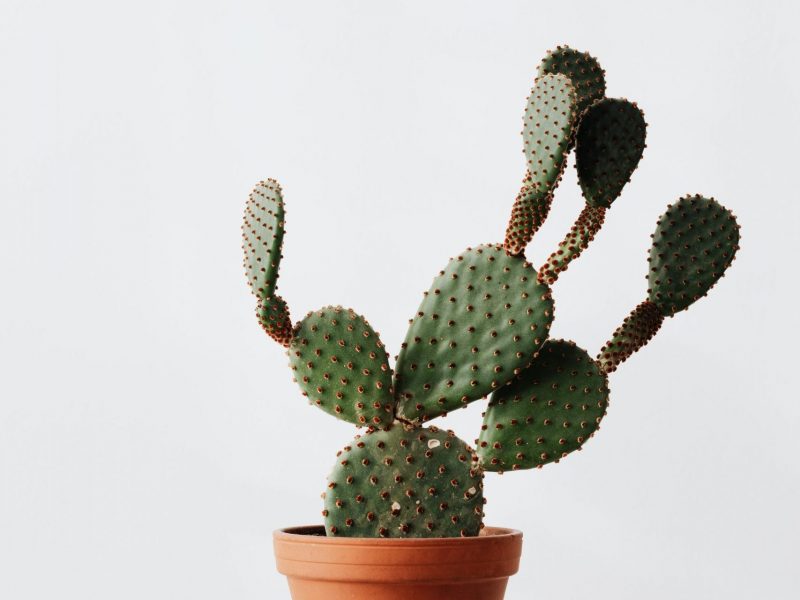
Named after the way their pads look, the Bunny Ears Cactus is great for plant parents who don’t want super huge spikey cacti in their home. They are easy to care for and look pretty cute too! However, just because they are relatively adaptable and aren’t as sensitive as a lot of other plant types, it doesn’t mean that you won’t run into issues with your Bunny Ears Cactus from time to time. In fact, brown pads/leaves can be quite common if your plant isn’t getting the right care, or something in their environment is amiss.
But don’t fret, if you have spotted some browning on your plant but it hasn’t taken over your entire Bunny Ears Cactus, then you should be able to nurture it back to full health. In this post, we will guide you through the most common reasons for brown Bunny Ears Cacti so you can figure out what is harming your plant and get right to fixing the problem.
Overwatering is the most common cause of browning
Overwatering is probably the most damaging of houseplant issues and is quite a common reason why Bunny Ears Cacti develop brown leaves. As with all types of cacti (and most succulents too), the Bunny Ears Cactus hates having really moist soil. They have very delicate and shallow roots so they are very susceptible to root rot. This will cause your Bunny Ears Cactus to turn soft, droop down and turn brown.
To figure out if overwatering is the reason your Bunny Ears Cactus is turning brown, check the moisture levels in the soil immediately. Don’t wait for the problem to resolve itself as that could be the difference between saving your plant and saying goodbye to your plant.
If the potting mix is waterlogged and feels clumpy then replace it with fresh dry potting mix which will allow the plant to start to recover. Trim away the rotten roots and adjust your watering schedule moving forward. With cacti, they like a good soak and need enough time for the potting mix to fully dry out. The most common reason why plant parents overwater the Bunny Ears Cactus is that they water them too often. It’s better to water them less frequently but give them a good soak each time.
Temperature shock can also cause brown patches
Your Bunny Ears Cactus could also be suffering from temperature shock which is causing brown patches across the plant. This often occurs if your Bunny Ears Cactus is too close to a heating/AC vent, radiator or is pretty close to a drafty window or door. As Bunny Ears Cacti are native to Mexico, they like warm temperatures but can dry out if extremely high so it’s about finding the right balance.
We recommend buying a digital thermometer to check the spot your Bunny Ears Cactus is sitting so you can be sure they aren’t having to endure extreme or fluctuating temperatures.
Pests are a rarer but more worrying cause of brown leaves- brown scabs are scale insects
A slightly less common reason why your Bunny Ears Cactus may have brown leaves is a pest infestation. This won’t happen as often if your Cactus is only ever inside, but it can still occur from time to time. Brown scabs across the pads on your Bunny Ears Cactus is a sign that scale insects are taking hold of your plant.
If you find pests on your Bunny Ears Cactus, isolate it from all of your other houseplants to stop the spread of the pests (they can move around leaves that are close). Wash down your plant and remove the insects with pincers. You should also treat your Bunny Ears Cactus with an organic insecticide to fight the infestation.
Pests are a more difficult problem to solve, but it is possible if you persevere. We recommend also removing the worst affected brown areas to curb the initial growth of the infestation.
Those are the top 3 reasons why Bunny Ears Cacti develop brown pads or brown patches. All 3 can be quite worrying causes and can ultimately lead to your plant dying if not solved. This is why it’s super important to act quickly once you have established the cause of the brown leaves on your Bunny Ears Cactus. Giving your plants a good once over before watering them gets you into a routine to spot early warning signs and can really help to catch issues early, giving your plants the best shot at surviving.
To find out more about how to best take care of your Cactus, as well as propagation tips and other common problems, check out our Bunny Ears Cactus care guide.














